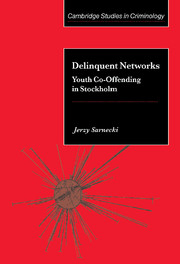Book contents
- Frontmatter
- Contents
- List of figures
- List of tables
- Acknowledgements
- 1 Social Network Analysis and Criminology
- 2 The Aims and Method of the Study
- 3 Actors and Links
- 4 The Choice of Co-offenders.
- 5 The Network
- 6 The Network Connections of Juveniles Admitted to Secure Care Facilities
- 7 Football Hooligans in the Networks
- 8 Politically and Ideologically Motivated Offences
- 9 Ethnicity
- 10 The ‘Ängen Gang’
- 11 Conclusions
- Appendix
- Notes
- References
- Index
11 - Conclusions
Published online by Cambridge University Press: 08 October 2009
- Frontmatter
- Contents
- List of figures
- List of tables
- Acknowledgements
- 1 Social Network Analysis and Criminology
- 2 The Aims and Method of the Study
- 3 Actors and Links
- 4 The Choice of Co-offenders.
- 5 The Network
- 6 The Network Connections of Juveniles Admitted to Secure Care Facilities
- 7 Football Hooligans in the Networks
- 8 Politically and Ideologically Motivated Offences
- 9 Ethnicity
- 10 The ‘Ängen Gang’
- 11 Conclusions
- Appendix
- Notes
- References
- Index
Summary
Anything new?
The research presented in this book constitutes the second study where I have employed network analysis in the examination of juvenile delinquency. As has been pointed out, analyses of this kind have become fairly common within the social and behavioural sciences more generally, whilst they remain rare in the field of criminology.
Traditional, quantitative analyses in the social sciences often work on the implicit assumption that individuals are not related to one another, an assumption which is at odds with the majority of social scientific theories. Network analysis, on the other hand, makes the assumption that actors are related to one another and thus provides a more nuanced picture of the social phenomena being studied by taking these relations into consideration (and often focusing on them quite specifically).
Even though network analysis is still rarely used in criminological studies, many criminological theories on the causes of crime (i.e. those of a sociological nature) are grounded in the assumption that delinquency is affected (or quite simply caused) by interactions or relations between various actors. Such theories are therefore highly compatible with the network perspective.
At the same time the various theories are based on a number of different views of both society and the individual. They thus have different things to say about the way individuals influence one another, and about the effects of this influence. Certain theories view delinquency as a behaviour learned in the course of interactions between actors, for example, whilst others talk instead of the transference of different elements of cultures/subcultures such as norms and values. Still others describe such influences in terms of the transmission of control.
- Type
- Chapter
- Information
- Delinquent NetworksYouth Co-Offending in Stockholm, pp. 157 - 169Publisher: Cambridge University PressPrint publication year: 2001
- 1
- Cited by

